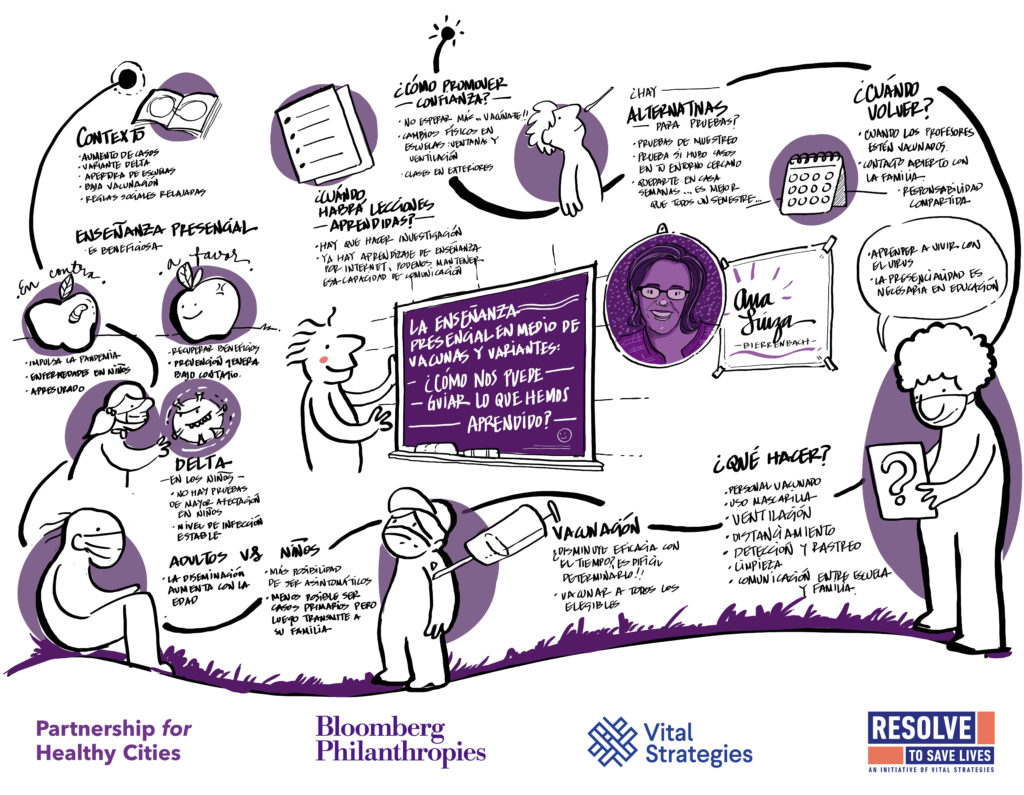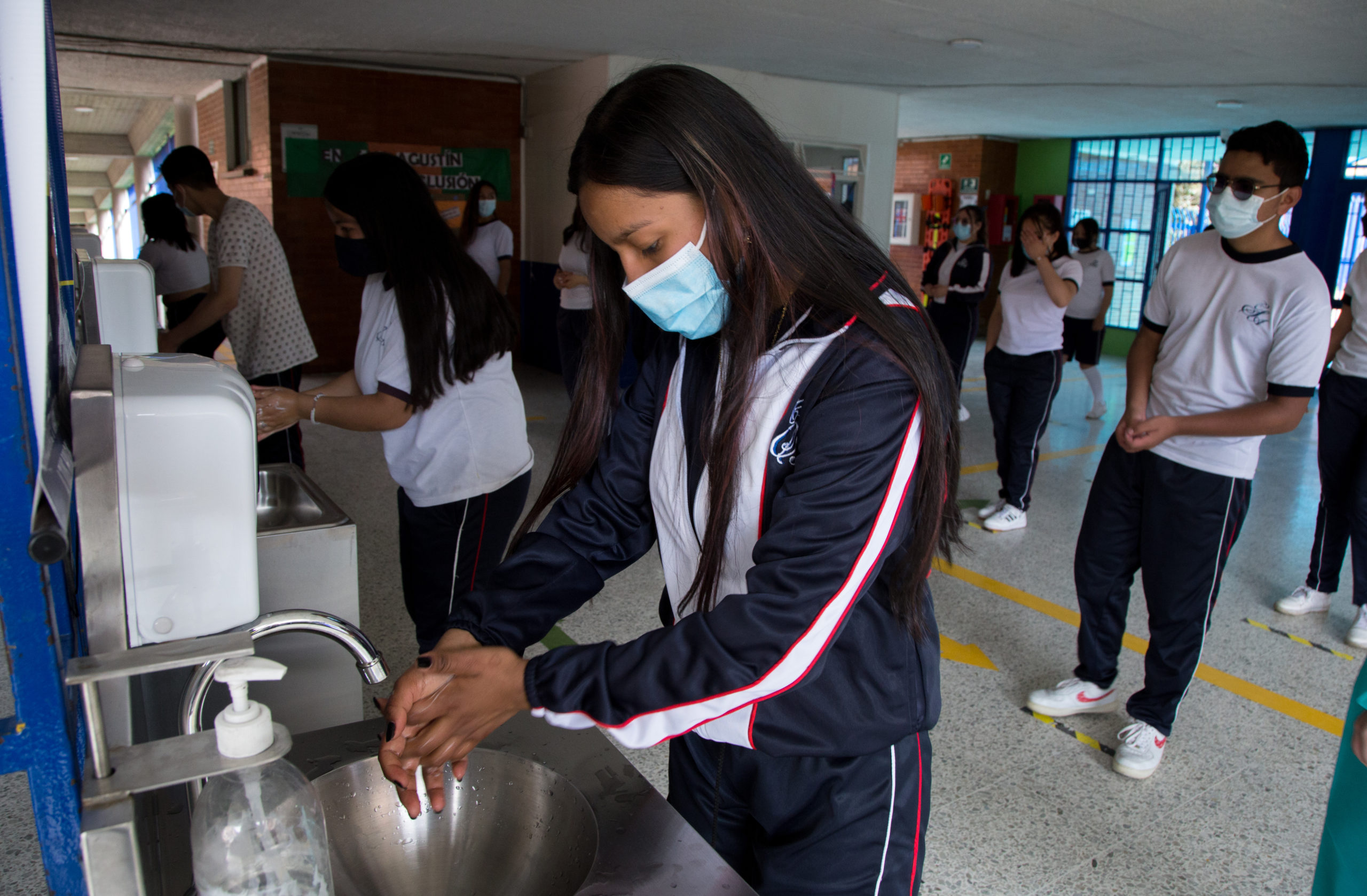School reopenings in Latin America are raising questions for urban leaders about how to strike a balance between COVID-19 health threats and the benefits to children of in-person learning—at a time when vaccines are scarce in some countries and children may not be first in line to receive a shot.
In an October Partnership for Healthy Cities webinar, leaders from cities where schools in many cases had been closed for a year and a half asked: Are we welcoming students back too soon?
“Now is the time to try,” infectious disease epidemiologist and researcher Ana Luiza Bierrenbach of Resolve to Save Lives, an initiative of Vital Strategies, told representatives from nine Latin American cities in the Partnership’s global network: Buenos Aires and Córdoba, Argentina; Santiago, Chile; Bogotá, Cali and Medellín, Colombia; Quito, Ecuador; Mexico City, Mexico; and Lima, Peru.
Dr. Bierrenbach said reopenings are timely as long as COVID-19 transmission rates in the schools remain the same as in the larger community, citing data showing that although children may infect others at home, they continue to be at lower risk than adults of contracting and transmitting COVID-19 overall.
Bierrenbach, formerly with the World Health Organization, cautioned, however, that cities and school officials must be willing to enforce proven mitigation strategies: vaccinated staff, consistent face mask use, continued distancing, handwashing, regular COVID testing, increased ventilation inside classrooms and outdoor classrooms when possible and increased communication with families.
“Returning to school is part of learning to live with the virus,” she said.

Several participants asked if countries such a Mexico and Peru, where only about where only about 50% of the population is vaccinated, should wait for higher vaccination rates before joining neighboring nations in holding in-person classes—considering the ongoing threat of the highly contagious Delta variant.
Bierrenbach advised that schools in places with low vaccination rates lean more heavily on other proven measures.
“Vaccination of all adults and adolescents is the most powerful tool we have,” she said, but that does not discount standard, evidence-based public health protocols or more recent pandemic learnings about what works and what does not work.
For instance, strong two-way communication between schools and families is vital, she said, arguing that reopening schools safely is the shared responsibility of schools and parents. Families need to be able go to teachers and school directors with questions, and vice versa. An example would be a teacher proactively asking a parent, “I’ve noticed your child has a bit of a cough. Are there people in your home with a cough?”
Reopening schools safely is the shared responsibility of schools and parents.”
—Ana Bierrenbach, Resolve to Save Lives
Additionally, schools in areas with low vaccination rates across population can emphasize staff vaccination and increase classroom ventilation. Bierrenbach said of ventilation strategies, “This is important not just for COVID, but also flu and other respiratory diseases. And not just for now. We’re going to change our way of doing things forever.”
Other cities asked about alternatives to testing in cities where supplies are low. The recommendation: Test only those with symptoms. Students and staff should stay at home until they can take a test. “By now, people know the symptoms and how transmission works,” she said. “Staying at home for a week is fairly easy. It’s better than missing a whole semester.”
Bierrenbach urged the cities to remember that they can be part of ongoing research into important questions around the impact of COVID-19 on childhood development and growth. While it’s clear now for instance that online teaching is a viable option for future emergencies, the long-term impact on children who had to stay at home for almost two years is still unknown.
The session concluded with a call to participants to share information about their cities’ efforts at school reopenings, including experiences, strategies and data—and to continue reaching out to the Partnership network as the situation develops.
Learn more about the Partnership for Healthy Cities
Get Our Latest Public Health News
Join our email list and be the first to know about our public health news, publications and interviews with experts.
About the Partnership for Healthy Cities:
The Partnership for Healthy Cities is a prestigious global network of cities committed to saving lives by preventing noncommunicable diseases (NCDs) and injuries. Supported by Bloomberg Philanthropies in partnership with WHO, as well as Vital Strategies, this initiative enables cities around the world to deliver a high-impact policy or programmatic intervention to reduce NCDs and injuries in their communities. For more information, visit: www.cities4health.org and https://partnershipforhealthycities.bloomberg.org/
By collaborating with the WHO and Resolve to Save Lives, an initiative of Vital Strategies, the Partnership for Healthy Cities COVID-19 Response is working hand-in-hand with the world’s leading experts on epidemic prevention.
